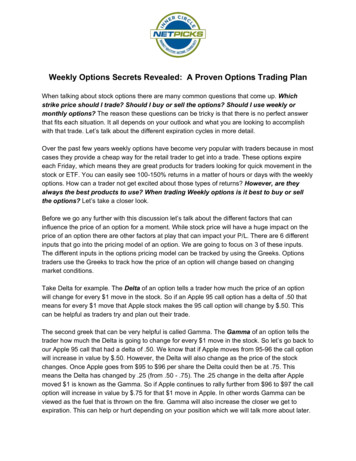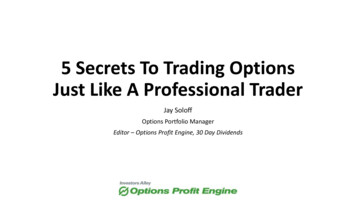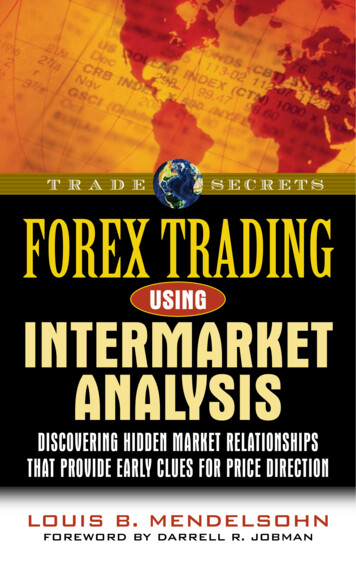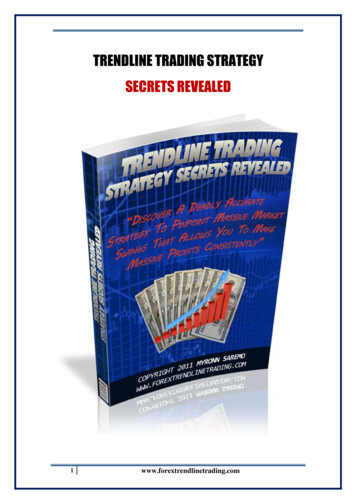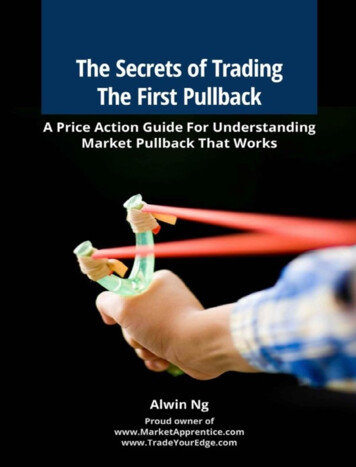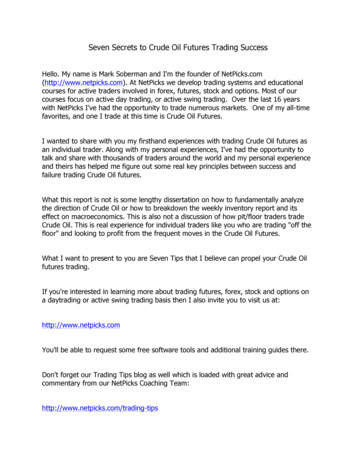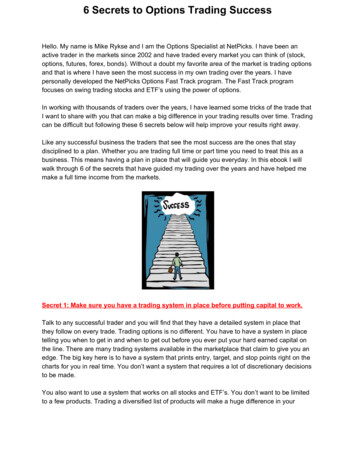
Transcription
6 Secrets to Options Trading SuccessHello. My name is Mike Rykse and I am the Options Specialist at NetPicks. I have been anactive trader in the markets since 2002 and have traded every market you can think of (stock,options, futures, forex, bonds). Without a doubt my favorite area of the market is trading optionsand that is where I have seen the most success in my own trading over the years. I havepersonally developed the NetPicks Options Fast Track program. The Fast Track programfocuses on swing trading stocks and ETF’s using the power of options.In working with thousands of traders over the years, I have learned some tricks of the trade thatI want to share with you that can make a big difference in your trading results over time. Tradingcan be difficult but following these 6 secrets below will help improve your results right away.Like any successful business the traders that see the most success are the ones that staydisciplined to a plan. Whether you are trading full time or part time you need to treat this as abusiness. This means having a plan in place that will guide you everyday. In this ebook I willwalk through 6 of the secrets that have guided my trading over the years and have helped memake a full time income from the markets.Secret 1: Make sure you have a trading system in place before putting capital to work.Talk to any successful trader and you will find that they have a detailed system in place thatthey follow on every trade. Trading options is no different. You have to have a system in placetelling you when to get in and when to get out before you ever put your hard earned capital onthe line. There are many trading systems available in the marketplace that claim to give you anedge. The big key here is to have a system that prints entry, target, and stop points right on thecharts for you in real time. You don’t want a system that requires a lot of discretionary decisionsto be made.You also want to use a system that works on all stocks and ETF’s. You don’t want to be limitedto a few products. Trading a diversified list of products will make a huge difference in your
6 Secrets to Options Trading Successreturns. Markets change and you want a system that can adjust to those changes quickly. Thisis the only way you can stay disciplined to your system.I use this example with traders all the time. Would you ever try to build a house withoutblueprints? It would be a long shot to do and have it turn out. Trading is no different. You haveto have the blueprints there to guide you on every trade. If you don’t you are left taking tradeswith your fingers crossed hoping they work out. Using a trading system will put a methodology inplace that you can trust when putting your hard earned capital to workThe system that I use in my own trading is the NetPicks Options Fast Track. It is our reversalsetup which takes advantage of market extremes. You can see a screenshot of this system inaction below. If you are looking for a system that puts the odds in your favor then click on thelink below and I’m willing to share this setup with your free of charge. This will give you achance to see what it looks like to use a system that gives clear entries and exits in real time.Click Here for Options Fast Track Reversal SystemYou can see from the screenshot below we have exact entry, target, and stop levels in placebefore we ever put our hard earned money into a trade.Secret 2: Weekly vs Monthly Options.Which should I trade?
6 Secrets to Options Trading SuccessWhen talking about stock options there are many common questions that come up. Whichstrike price should I trade? Should I buy or sell the options? Should I use weekly ormonthly options? The reason these questions can be tricky is that there is no perfect answerthat fits every situation. It all depends on your outlook and what you are looking to accomplishwith that trade. Let’s talk about the different expiration cycles in more detail.Over the past few years, weekly options have become very popular with traders because inmost cases they provide a cheap way for the retail trader to get into a trade. These optionsexpire every Friday, which means they are great products for traders looking for quickmovement in the stock or ETF. With the cheaper price many traders view the weekly’s as safertrades.However, are they always the best products to use?When deciding whether we should use the weekly or monthly options, it depends on our outlookfor the stock or ETF. If we are expecting a quick move within the next few days, then the weeklyoptions will give us the most bang for our buck. This is due to the fact that Gamma, ordirectional risk, is higher the closer we get to expiration (see chart below). As a result of thehigher gamma in the weekly options, the price of those options will react quicker to movement inthe stock. The key take away here is we will see more powerful moves as long as themove happens quick enough.However, options are decaying assets which means the longer we hold them the more timevalue comes out. The weekly options will allow us to make money faster if we get a quick movein our favor. The problem here is if the trade takes longer than anticipated the time decay willhurt our position very quickly. The weekly options just don’t give us much margin for error. With
6 Secrets to Options Trading Successthis in mind, I recommend using more monthly options. Even though you will pay morewhen trading the monthly options, you are building in a safety net just in case the trade doesn’thappen as quickly as anticipated. Our sweet spot is to look for options with between 20-40days left to expiration.Secret 3: Trade the In-The-Money OptionsBuying Calls or Puts:When buying a long call or put we need to make sure we have a strong opinion on which waythe stock or ETF is headed in the near term. We have to keep in mind that whenever we buy anoption the clock is ticking the second we decide to initiate the trade. The time decay will start toadd up and potentially eat into the profit potential that we have. This means not only do we needto be right on market direction, but the move needs to happen in our favor quick enough.To combat some of the negative features of buying an option, we like to be very picky with thecriteria that we use when selecting the call or put option. First, we don’t pick the option based onwhat we can afford like so many retail traders make the mistake of doing. In many cases, thiswill leave you with an out of the money option which has a very low probability of success.Instead, we like to trade the in the money options.Our criteria has us going out 20-40 days until expiration and buying the call or put optionthat is 1-2 strikes in the money. This criteria is the same whether we are trading GOOGL,DIA, or C. By using the same criteria on all stocks and ETF’s, we are able to take much of thediscretionary decisions out of the equation.Buying Vertical Spreads:When using a long vertical spread, we still need to have a strong opinion on which way thestock or ETF is heading in the near term. While the time decay is still going to be there like witha long call or put, the long vertical spread is able to limit the effect of the time decay slightly. Welike to use the long vertical spread when we desire to be in a more conservative position. Weare able to do this because a long spread is constructed by both buying an option and selling anoption with a different strike price at the same time. Vertical spreads offer a unique ability tocontrol risk and reward by allowing us to determine our maximum gain, maximum loss,break-even price, maximum return on capital, and the odds of having a winning trade, all at thetime we open a position.
6 Secrets to Options Trading SuccessWhen setting up a long vertical spread we still like to trade the options that have between20-40 days left until expiration. We structure the trade by always buying the option that is1 strike in the money and then selling the strike that is closest to our target for that stockor ETF in the near term. The nice part about using this simple criteria is that it is the samewhen using call or put options. The criteria is also the same regardless of the symbol of thestock we are trading.
6 Secrets to Options Trading SuccessSo why wouldn’t we trade a spread on every trade? While it’s great that vertical spreads limitthe risk, they also limit the profit potential at the same time. Our profit is limited to differencebetween the strike prices minus what we paid for the trade. For example, if we are putting onthe long 25/30 call spread that would have us buying the 25 call and then selling the 30 call.This leaves us with a 5 wide call spread. If we paid 2.00 for the spread our maximum profitpotential would be 3.00. This is calculated by taking the 5 difference between the strikes andsubtracting the 2.00 price that we paid for the spread.Many newer traders get intimidated by trading spreads because they think they will be left withhuge risk. However, in reality the long vertical spread is actually safer than buying an outrightcall or put. The reason for this is that we can never lose more than what we paid for the verticalspread. It is a defined risk trade. This is due to the fact that we are buying the option that is onestrike in the money and at the same time offsetting some of that cost by selling the option that isfarther out of the money. As a result we are able to lower the overall cost of the trade.The long vertical spread is one of my favorite trade types and should be a part of your overalloptions toolbox.Secret 4: Risk Management - Position SizingOne of the biggest reasons for traders failing to reach their trading goals is trading positions thatare way too big for their account size. I hear it all the time from newer students, “If I just hit a fewbig winners the whole game changes for me.” This approach is completely backwards thinking.When trading with a small account size, it’s crucial to focus on consistent growth over time. Ifyou can focus on small winners on a regular basis you will see the power of compounding takeover.I would also much rather see a newer trader take 5-6 small positions instead of 1-2 bigpositions. With any trading system out there the statistics become more significant as thesample set of trades becomes larger. If you are just taking 1 or 2 trades at a time, it becomes along shot to see the results you are looking for. However, if you are taking 5-6 trades now all thesudden we can get more diversification built in and also build our sample set of trades larger tomake sure the odds are in our favor.Having a risk management rule in place is crucial to trading success. I have included a samplerisk management template below:Sample Risk Template:Determine what % of your account size you are willing to have at risk.In my plan I use the 50% number. This rule says I will not have more than 50% of my accountsize at risk at any one time. If I am using a 50,000 account this means I can’t have more than 25,000 at risk across all my different positions. So I would have 25,000 to work with spread
6 Secrets to Options Trading Successacross the 26 names on my watch list. If I reach that 25,000 limit and I get new trades to setup, then I need to either close out of some existing trades to free up capital in order to get backbelow the 25,000 level or skip the trade. The 50% number works for me and is a level I amcomfortable with. That number could be different for you. It could be 25% or 60%. The numberdoesn’t matter to me as long as you are comfortable with that level of risk and it’s somethingyou can stay disciplined to following.Secret 5: Have a small universe of stocks/ETF’s that you look at on a regular basis***See attached worksheet below***The most overwhelming issue that comes up for a trader on a daily basis is how to find the besttrades for that day or week. There are thousands of stocks and ETF’s out there that you cantrade everyday. Instead of scanning this big list of products on a daily basis, we recommendnarrowing the universe of products down to a smaller list that we can get to know really well.This way we can establish a sample set of trades that is large enough to make sure the oddsare in our favor.I write and talk about this all the time in our training materials. I don’t want to look at thousandsof names on a daily or weekly basis because in many cases you will be left trading names thatyou aren’t familiar with. I would rather focus on a small list of stocks and ETF’s that I get to knowover time. This way I can easily determine whether I am bullish, bearish, or neutral withoutspending a ton of time each day staring at the charts.My watch list can change once a month. Currently my personal watch list is 26 products. These26 names come from my universe of 50 stocks and ETF’s that I track on a monthly basis. Inother words, when I created my watch list of 26 names for the month, those names came frommy universe of 50 products that I have tracked and researched for an extended stretch of time.We will share more insight into my favorite Stocks/ETF’s in Worksheet A at the end of theEBook which includes a great list that you can start trading today.Secret 6: Keeping a Trade JournalMany successful traders talk about how important it is to keep a trade log. I actually like the term' Trade Journal' much better. When I think about keeping a trade log, it typically just requiresyou to document where you got in and out of each trade. Keeping an actual trade journal ismore detailed. Documenting each trade that you take is crucial in any type of trading. However,I also like to keep detailed notes on each trade to keep track of more statistics than just entryand exit points.
6 Secrets to Options Trading SuccessSome of the data that I like to track are things like:Entry date Exit date Entry Point Exit Point P/L Average holding time Types of trades (if your syst
06.05.2019 · walk through 6 of the secrets that have guided my trading over the years and have helped me make a full time income from the markets. Secret 1: Make sure you have a trading system in place before putting capital to work. Talk to any successful trader and you will find that they have a detailed system in place that they follow on every trade. Trading options is no different. You have to have a
